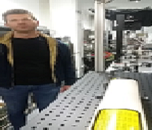Scientific Program
Keynote Session:
Title: Laser drilling of metals in water: A model
Biography:
Julio Car got his Master’s degree at the University of Natural Sciences in Zagreb, Croatia in the field of physics. During his education he participated in 3 International Olympiads in Astronomy and Astrophysics in China (2009.), Ukraine (2010.) and Poland (2011.). Currently, he is doing PhD in atomic and molecular physics at the Institute of physics in Zagreb. His field of study is laser ablation of materials and production of nanoparticles used for impregnation in polymers in order to achieve better surface properties as well as in photocatalysis. Regarding publications, he is co-author of scientific poster titled “Determination of concentration of laser synthesized Ag nanoparticles in water” and co-author of paper titled “Photodegradation of Methylene Blue and Rhodamine B Using Laser-Synthesized ZnO Nanoparticles”, Materials (Q2). Majority of his work is based on theoretical modelling of parameters of colloidal solutions of metal nanoparticles: cross sections, diameter, concentration, volumes and absorbances of nanoparticles.
Abstract:
Laser drilling of metals in water is essential method for synthesis of nanoparticles with adjustble size distribution and morphology given that there are many experimental parameters (energy, frequency, wavelength, pulse duration, number of pulses, width of the pulse...) which determine characteristics of obtained nanoparticles. One of the most important quantites dependent on these parameters are volumes of craters from which concentration and diameter of produced nanoparticles may be determined. This work shows that Gaussian profile of laser pulses used for drilling of craters projects itself into the Gaussian profile of obtained crater depth vs. radius dependence. Basis of the model is assumption that fluence dependence on width of the laser pulse has the same mathematical form as depth of the crater dependence on the radius of the crater. Corresponding equations for those dependencies were derived which allowed derivation of formula for volume of Gaussian crater. In this work two methods of determining volume of craters will be presented and compared for verification of obtained results. First method is based on observing of crater as piecewise truncated cones and summing of their volumes in order to get full crater volume while the second considers the physics of Gaussian laser pulse projection on Gaussian shape of crater profile where parameters are determined by fitting of modified Gaussian profile on crater profile. By measuring energy of laser pulses using iris, laser pulse waist ![]() was found which isn't the same as waist radius
was found which isn't the same as waist radius ![]() of the crater neither before nor after lens focusing. Comparison of volumes of craters measured by optical microscopy and modeled ones with modified gaussian fit show discrepancy in range % for Ag ,% for ZnO and % for Au. Developed model states that there are 3 relevant points for full crater description given it has Gaussian profile: surface radius, depth and Gaussian waist which equals to the radius at depth. Comparison of volumes of craters measured by optical microscopy and modeled ones with 3 points gaussian fit show discrepancy in range % for Ag, % for ZnO and % for Au. Fluence profile of Gaussian laser pulses and areas of successive crater holes drilled with each pulse enables calculation of deposited energy in the crater where crucial parameters are ablation threshold of given metal for given wavelength and pulse duration and incident energy upon metal target. Obtained energies are bounded with lower limit which corresponds to minimal energy needed for heating, melting and evaporation of given mass of metal target and upper limit given as a maximal energy incident upon metal target for given number of laser pulses. Difference in upper limit energy and deposited energy equals to heat diffusion to the crater surroundings and radiation of ignited plasma during laser ablation.
of the crater neither before nor after lens focusing. Comparison of volumes of craters measured by optical microscopy and modeled ones with modified gaussian fit show discrepancy in range % for Ag ,% for ZnO and % for Au. Developed model states that there are 3 relevant points for full crater description given it has Gaussian profile: surface radius, depth and Gaussian waist which equals to the radius at depth. Comparison of volumes of craters measured by optical microscopy and modeled ones with 3 points gaussian fit show discrepancy in range % for Ag, % for ZnO and % for Au. Fluence profile of Gaussian laser pulses and areas of successive crater holes drilled with each pulse enables calculation of deposited energy in the crater where crucial parameters are ablation threshold of given metal for given wavelength and pulse duration and incident energy upon metal target. Obtained energies are bounded with lower limit which corresponds to minimal energy needed for heating, melting and evaporation of given mass of metal target and upper limit given as a maximal energy incident upon metal target for given number of laser pulses. Difference in upper limit energy and deposited energy equals to heat diffusion to the crater surroundings and radiation of ignited plasma during laser ablation.


